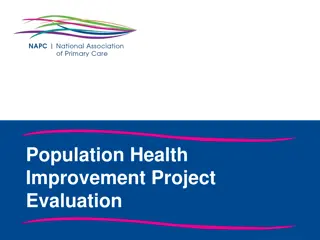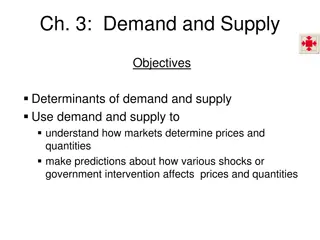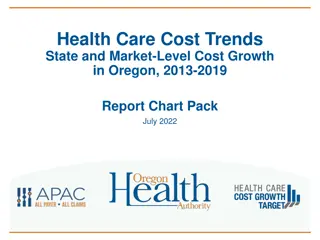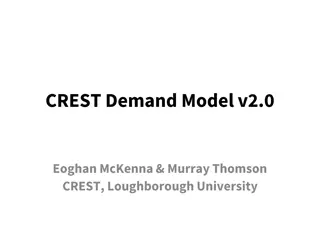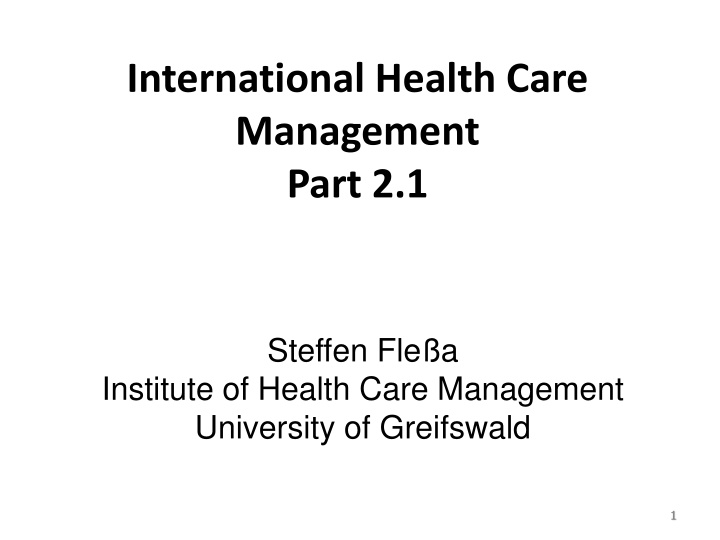
International Health Care Management Part 2 - Structure and Demand Analysis
This content delves into the structure of international public health systems, demand for health services, determinants of demand, health economic frameworks, demographic transitions, epidemiology of infectious diseases, and more, providing a comprehensive overview of healthcare management.
Download Presentation

Please find below an Image/Link to download the presentation.
The content on the website is provided AS IS for your information and personal use only. It may not be sold, licensed, or shared on other websites without obtaining consent from the author. If you encounter any issues during the download, it is possible that the publisher has removed the file from their server.
You are allowed to download the files provided on this website for personal or commercial use, subject to the condition that they are used lawfully. All files are the property of their respective owners.
The content on the website is provided AS IS for your information and personal use only. It may not be sold, licensed, or shared on other websites without obtaining consent from the author.
E N D
Presentation Transcript
International Health Care Management Part 2.1 Steffen Fle a Institute of Health Care Management University of Greifswald 1
Structure 1 International Public Health 2 Demand for Health Services 3 Supply of Health Services 4 Health Systems and Reforms 2
2 Demand for Health Services 2.1 Determinants of Demand: Overview 2.1.1 Health Economic Framework 2.1.2 History of Epidemiologic Concepts 2.1.3 Excursus: Measuring Quality of Life 2.2 Demographic and Epidemiologic Transition 2.3 Epidemiology of Infectious Diseases 3
OBJECTIVE SCARCITY OFHEALTH 5
OBJECTIVE SCARCITY OFHEALTH SUBJECTIVE EXPERIENCE OF SCARCITY = NEED 6
OBJECTIVE SCARCITY OFHEALTH SUBJECTIVE EXPERIENCE OF SCARCITY = NEED WANT 7
OBJECTIVE SCARCITY OFHEALTH SUBJECTIVE EXPERIENCE OF SCARCITY = NEED WANT DEMAND 8
OBJECTIVE SCARCITY OFHEALTH Demography Infectious Diseases Chronic Degenerative Diseases SUBJECTIVE EXPERIENCE OF SCARCITY = NEED WANT DEMAND 9
OBJECTIVE SCARCITY OFHEALTH Demography Infectious Diseases Chronic Degenerative Diseases Health Education SUBJECTIVE EXPERIENCE OF SCARCITY = NEED WANT DEMAND 10
OBJECTIVE SCARCITY OFHEALTH Demography Infectious Diseases Chronic Degenerative Diseases Health Education SUBJECTIVE EXPERIENCE OF SCARCITY = NEED Affordability Health Budgets of Private Households Price Policy Health Insurance Friction of Distance Utility Quality Measurement Assurance WANT DEMAND 11
2.1.2 History of Epidemiologic Concepts Age Causal Model Concepts of Health Health Indicators Mortality Morbidity (Prevalence, Incidence) Work-Related Dimensions of Invalidity (Inability to Work, Disability) 1900 Single-Cause-Model (Infectious Diseases) Ecological-Model (Agent-Host- Environment) 1920 Multiple-Cause- Model (Infectious Diseases, Transition to Chronic Diseases) Social-Ecology- Model (Host- Environment- Behavior) 12
Age Causal Model Concepts of Health Health Indicators 1940 WHO-Model: Complete Physical, Mental, Social Wellbeing Risk-Factor-Model Holistic Model (Environment, Biology, Lifestyle, Health Care System) WHO-Model: Health for all by 2000 1970 Multiple-Cause- Model Multiple-Effect- Model (Chronic Diseases) Dimensions of Risk Factors (Smoking, Alcohol, Cancer Registry,...) 13
Age Causal Model Concepts of Health Health Indicators Dimensions of Wellness, Quality of Life (QALY) 1980 Wellness-Model (Increasing Conditions of Wellness) WHO: Health Promotion Developing Healthy Policies 1990 Multiple-Cause- Multiple-Effect Model (Social Transformation Disease Cycle) Dimensions of Equity Dimensions for Social Index (cf. Dever 1991) 14
Example: Attention Deficit Hyperactivity Syndrome (ADHS) Cardinal Symptoms: Low attention span Impulsiveness Hyperactivity NB: Attention Deficit Syndrome (ADS) without Hyperactivity ( Dreamer ) Starts before the age of 6 Occurrence: 3-5% of the population; 1:3 female:male 15
ADHS Causes (Risk Factors) Genetic: Abnormality of the cerebral ability to process signals (fragile X-Syndrome) Complications during pregnancy and birth Low birth weight Infection Pollutants Illness or injury of the central nervous system Bad parenting, negligence No direct correlation between cause and effect 16
2.1.3 Excursus: Measuring Quality of Life Measuring Individual Quality of Life Analogue model Questionnaires i.e. SF-12, SF-36 Standardized Measures of Quality of Life Rosser-Matrix Quality Adjusted Life Years Disability Adjusted Life Years 17
Analogue Model 100 0 18
SF-36 (https://www.rand.org/health-care/surveys_tools/mos/36-item-short-form.html) 19
Rosser Matrix Pain Impairment A: Painless B: Slight Pain C: Moderate Pain D : Severe Pain I. No impairment 1.000 0.995 0.990 0.967 II. Slight Social Impairment 0.990 0.986 0.973 0.932 III. More Severe Social Impairment 0.980 0.972 0.956 0.912 IV. More Severe I. of the Ability to Work 0.964 0.956 0.942 0.870 V. Inability to Work 0.946 0.935 0.900 0.700 VI. Inability to Move without Assistance 0.875 0.845 0.680 0 VII. Bedrest 0.677 0.564 0 -1.486 VIII. Coma -1.028 - - - 20
Disability Adjusted Life Years (DALY) Von Original: Planemad Vektor: Radio89 - Diese Datei wurde von diesem Werk abgeleitet: DALY disability affected life year infographic.png:, CC BY-SA 3.0, https://commons.wikimedia.org/w/index.php?curid=20278903
States of Health According to DALYs Rating of State of Health State of Health Limited capability of performing at least one activity in one of the following areas: relaxation, education, procreation, profession Limited capability of performing most activities in one of the following areas: relaxation, education, procreation, profession Limited capability of performing activities in two or three of the following areas: relaxation, education, procreation, profession 0.096 0.220 0.400 Limited capability of performing most activities in all four areas 0.600 Need for assistance in instrumental activities of daily life, i.e. preparing meals, grocery shopping, household chores Need for assistance in activities of daily life, i.e. eating, personal hygiene, toilette 0.810 0.920 Death 1.000 22
DALYs (http://www.who.int/healthinfo/global_burden_disease/GBD2004_DisabilityWeights.pdf) 23
Disability Weight and Culture Example: Vitiligo chronic skin disease Loss of pigment European: low disability African/Asian: strong disability Frequently confused with leprosy International disability weight is wrong! 24
Remaining Life Expectancy according to DALYs Age 0 1 5 10 15 20 25 30 35 Male 80.00 79.36 75.38 70.40 65.41 60.44 55.47 50.51 45.57 Female 82.50 81.84 77.95 72.99 68.02 63.08 58.17 53.27 48.38 25
Age 40 45 50 55 60 65 70 75 80 85 90 95 Male 40.64 35.77 30.99 26.32 21.81 17.50 13.58 10.17 7.45 5.24 3.54 2.31 Female 43.53 38.72 33.99 29.37 24.83 20.44 16.20 12.28 8.90 6.22 4.25 2.89 26
Value of One Year of Life in the Calculation of DALYs 2 Relative Value of One 1.5 Year of Life 1 0.5 0 0 20 40 60 80 100 Age 27
At a discounting rate of 3 % and the described age adjustment the loss of DALYs due to illness or disability can be described accordingly: D L Value of state of health according to the table Period of physical disability; respectively loss of years lived due to premature death Age of starting physical impairment; respectively year of death Age a x 28
29 No data
2 Demand for Health Services 2.1 Determinants of Demand 2.1.1 Health Economic Framework 2.1.2 History of Epidemiologic Concepts 2.1.3 Excursus: Measuring Quality of Life 2.2 Demographic and Epidemiologic Transition 2.3 Epidemiology of Infectious Diseases 30













